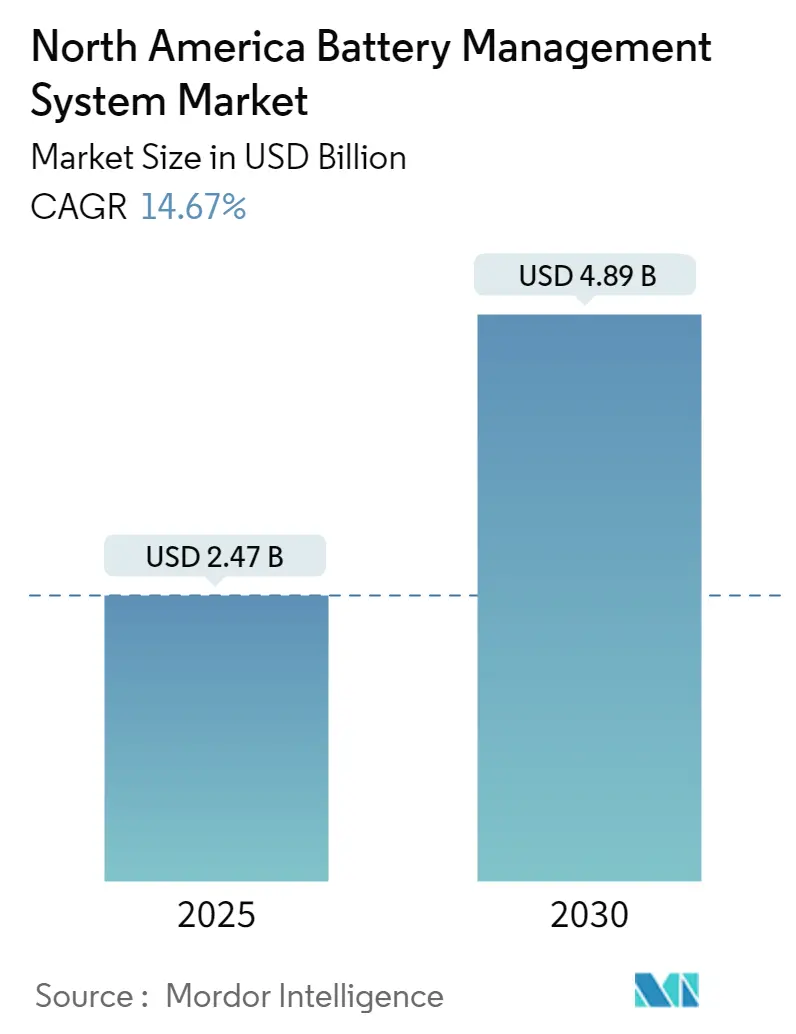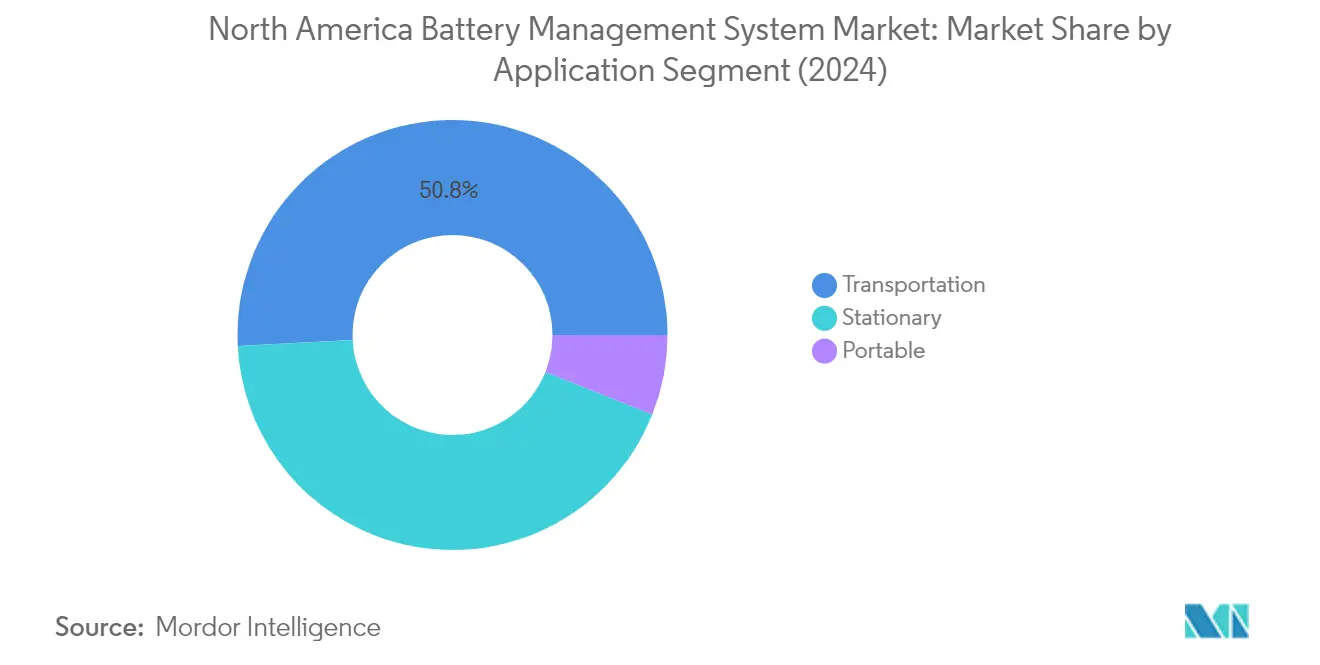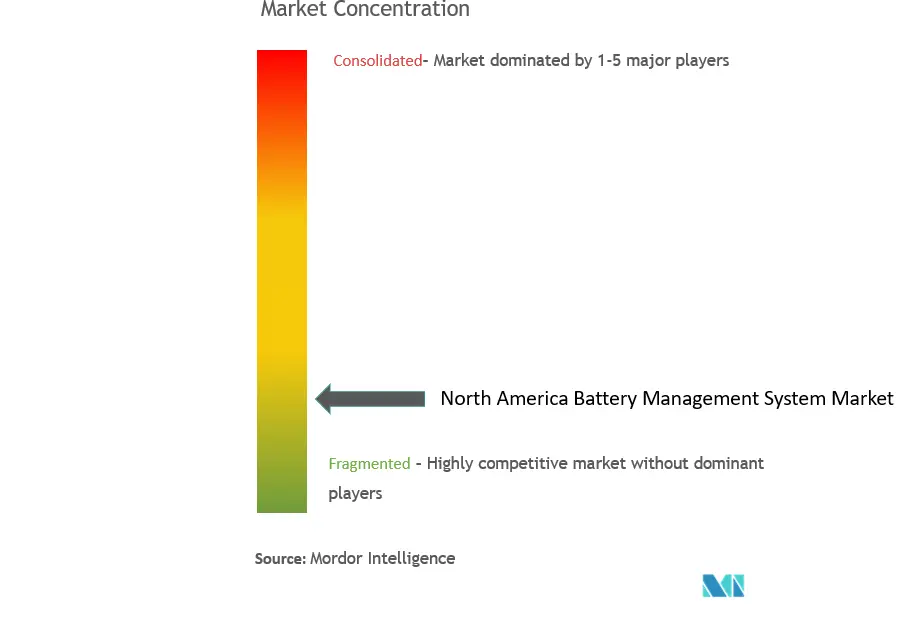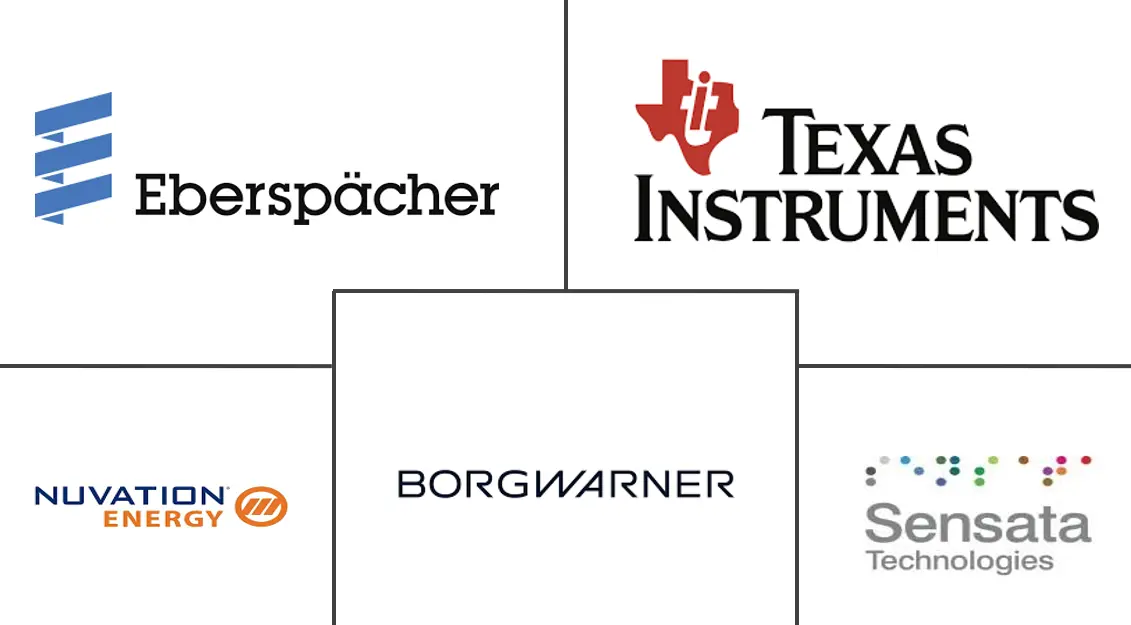
North America Battery Management System Market Analysis by Mordor Intelligence
The North America Battery Management System Market size is estimated at USD 2.47 billion in 2025, and is expected to reach USD 4.89 billion by 2030, at a CAGR of 14.67% during the forecast period (2025-2030).
The North American battery management system market is experiencing significant transformation driven by massive investments in manufacturing infrastructure and technological advancements. Major automotive manufacturers are establishing new production facilities across the region, with Honda announcing a USD 15 billion investment in April 2024 to construct four new manufacturing plants in Ontario for electric vehicles and EV batteries. This trend is further exemplified by the development of thirteen new battery cell gigafactories expected to come online in the United States by 2025, significantly expanding the region's battery manufacturing capabilities and creating a robust supply chain ecosystem.
The integration of battery energy storage systems (BESS) in power infrastructure has become increasingly critical for grid stability and renewable energy adoption. In 2023, approximately 6.4 GW of new utility battery energy storage capacity was added to the United States grid, representing a 70% annual increase from the previous year. This substantial growth in BESS deployment is driven by the rising need to store intermittent renewable energy and provide grid stability services, creating increased demand for sophisticated battery management systems that can ensure optimal performance and longevity of these large-scale installations.
The data center industry's rapid expansion is creating new opportunities for battery management system applications. As of 2023, the United States hosted over 5,387 data centers, with major technology companies continuing to invest heavily in new facilities. Microsoft's announcement in November 2023 to invest USD 500 million in new Quebec data centers, and Amazon AWS's February 2024 commitment of USD 5 billion for multiple data centers in Mexico, demonstrate the growing demand for reliable power backup solutions that require advanced battery management systems.
Technological innovation in battery management systems is advancing rapidly, with a focus on wireless battery management capabilities and artificial intelligence integration. Companies are developing wireless distributed battery management systems (wBMS) that eliminate physical connections, reducing wiring harness requirements by up to 90% and simplifying battery construction. Additionally, research initiatives like the "Longer" project are exploring machine learning applications to optimize battery capacity utilization and extend battery life in energy storage applications, indicating a shift toward more intelligent battery management solutions.
North America Battery Management System Market Trends and Insights
WIDESPREAD ADOPTION OF ELECTRIC VEHICLES
The rapid transition toward electric vehicles across North America has emerged as a significant driver for the battery management system market. The United States government's ambitious target, announced in March 2024, aims for 35% electric vehicle adoption by 2032, while Canada has committed to achieving 100% zero-emission vehicles under the new light vehicles category by 2035. These targets are supported by substantial investments, with the US government awarding approximately USD 1.7 billion in July 2024 to increase electric vehicle manufacturing across Michigan, Pennsylvania, and Georgia, benefiting companies like ZF North America, Accelera, and Volvo Group for expanding electric truck production.
The growing investment in battery thermal management infrastructure further reinforces this trend. As of July 2024, thirteen new battery cell gigafactories are expected to come online in the United States by 2025, being developed by major automobile manufacturers like Ford Motor Company and General Motors Company. In Canada, significant investments include Honda's USD 15 billion commitment announced in April 2024 to construct four new manufacturing plants in Ontario for both electric vehicles and EV batteries. Additionally, companies like BYD are expanding their presence in North America, with plans announced in May 2024 to manufacture about 150,000 hybrid electric trucks annually in Mexico, demonstrating the region-wide commitment to electric vehicle adoption.
SAFETY CONCERNS IN BATTERY SYSTEMS
Safety concerns regarding lithium-ion battery systems have become a critical driver for the adoption of sophisticated EV battery management systems. According to the International Energy Agency's estimates as of June 2023, approximately 4,125 electric cars catch fire annually in the United States, with plug-in hybrids and hybrid-electric cars being most susceptible due to their high-voltage battery packs. This safety concern is further highlighted by the New York Fire Department's report of 108 lithium-ion battery fire instances in the city as of August 2023, primarily occurring in transportation applications such as electric vehicles and e-bikes.
The industry is responding to these safety challenges through technological advancement and strategic partnerships. In June 2024, LG Energy Solution Ltd. (LGES) formalized a memorandum of understanding with Analog Devices Inc. (ADI) to enhance electric vehicle battery management solutions, specifically focusing on accurately gauging internal temperatures of electric vehicle battery cells. This collaboration exemplifies the industry's commitment to addressing safety concerns through improved monitoring and control systems. The significance of safety measures is further emphasized by incidents like the September 2023 fire at a 139 MW standalone battery energy storage facility in San Diego County, California, demonstrating the critical need for robust battery protection system across various applications, from individual vehicles to large-scale energy storage installations.
Segment Analysis: Application
Transportation Segment in North America Battery Management System Market
The transportation segment has emerged as the dominant force in the North America battery management system market, commanding approximately 51% of the total market share in 2024, while also maintaining the highest growth trajectory with a projected growth rate of around 17% during 2024-2029. This segment's prominence is primarily driven by the rapid adoption of electric vehicles across North America, with the United States leading the charge through ambitious government targets and substantial investments in EV infrastructure. The segment's growth is further bolstered by major automotive manufacturers' commitments to electrification, with several companies establishing new battery cell gigafactories and EV manufacturing facilities across the region. The increasing focus on vehicle safety, performance optimization, and battery monitoring systems in electric vehicles has made battery management systems an indispensable component in the transportation sector, particularly as manufacturers strive to meet stringent safety and performance standards while maximizing battery life and efficiency.

Remaining Segments in Application Market
The stationary and portable segments represent significant opportunities in the North America battery control system market, each serving distinct applications and end-user needs. The stationary segment caters to critical applications such as grid energy storage, uninterruptible power supplies (UPS), and telecommunications infrastructure, playing a vital role in ensuring power reliability and grid stability. This segment has gained particular importance with the increasing integration of renewable energy sources and the growing demand for reliable backup power solutions in data centers and commercial facilities. Meanwhile, the portable segment, though smaller in market share, serves essential applications in consumer electronics, medical devices, and portable industrial equipment, where efficient battery control systems are crucial for ensuring device longevity and user safety. Both segments benefit from technological advancements in battery thermal management systems, particularly in areas of thermal management, cell balancing, and remote monitoring capabilities.
North America Battery Management System Market Geography Segment Analysis
Battery Management System Market in the United States
The United States dominates the North American battery management system market, commanding approximately 87% of the total market share in 2024. The country's leadership position is reinforced by its well-developed automotive sector and aggressive transition towards electric vehicles, necessitating advanced automotive battery management solutions. The robust growth is supported by substantial government initiatives, including federal tax credits of up to USD 7,500 for new EVs and significant investments in battery manufacturing facilities. The country's commitment to renewable energy integration, with a target of achieving 80% clean energy generation by 2030, has created additional demand for energy storage management systems in grid storage applications. The presence of major technology companies and their expanding data center infrastructure further drives the demand for reliable battery monitoring system solutions. The market is particularly dynamic in states like Texas and California, where large-scale battery storage projects are being actively developed and implemented.
Battery Management System Market in Mexico
Mexico emerges as the most dynamic market in the region, projected to grow at approximately 16% annually from 2024 to 2029. The country's battery management system market is experiencing a transformative phase, driven by significant investments in electric vehicle manufacturing infrastructure. The establishment of major manufacturing facilities, including Tesla's USD 5 billion plant near Monterrey and Audi's billion-euro investment in Puebla, signals strong market potential. The government's commitment to deploying an additional 30 GW of renewable energy by 2030 is creating new opportunities for energy storage management systems in grid storage applications. The country's strategic position in North American manufacturing networks, combined with recent investments in data center infrastructure, is fostering a conducive environment for market growth. Despite challenges in consumer-level EV adoption, the industrial and commercial sectors continue to drive demand for sophisticated industrial battery management solutions.
Battery Management System Market in Canada
Canada's battery management system market is characterized by substantial investments in electric vehicle manufacturing and battery production infrastructure. The country's automotive sector is undergoing a significant transformation, with major manufacturers like Honda committing USD 15 billion for new manufacturing facilities in Ontario. The market is further strengthened by the development of numerous battery energy storage projects, including the Fitzroy and Trail Road Battery Energy Storage Systems. Canada's commitment to achieving net-zero emissions by 2050 is driving the adoption of power management system solutions across various applications. The country's focus on data center expansion, exemplified by Microsoft's significant investments in Quebec, is creating additional demand for reliable battery monitoring system solutions. The market also benefits from the growing adoption of renewable energy technologies and the increasing need for grid stabilization solutions.
Battery Management System Market in Other Countries
The remaining North American territories demonstrate varying levels of market development in the battery management system sector. These regions are characterized by emerging opportunities in renewable energy integration and industrial applications. The market development in these areas is primarily driven by increasing industrialization, growing awareness of energy storage solutions, and the gradual adoption of electric vehicles. While these markets may be smaller in scale, they play a crucial role in the overall regional market dynamics, particularly in specialized applications such as telecommunications and backup power systems. The future growth potential in these regions is closely tied to government initiatives promoting clean energy adoption and industrial modernization efforts.
Competitive Landscape
Top Companies in North America Battery Management System Market
The North American battery management system market is led by established players like Eberspächer, Texas Instruments, BorgWarner, and Sensata Technologies, who have demonstrated strong market presence through continuous innovation and strategic expansion. Companies are increasingly focusing on developing advanced battery management solutions incorporating artificial intelligence and machine learning capabilities to enhance battery performance and longevity. The industry has witnessed significant investment in research and development, particularly in wireless battery management technology and smart monitoring systems. Strategic collaborations between BMS providers and automotive manufacturers have become increasingly common, enabling integrated solutions for electric vehicles and energy storage applications. Market leaders are expanding their manufacturing capabilities while simultaneously strengthening their distribution networks to maintain competitive advantages and meet growing demand across various end-user segments.
Diverse Players Shape Dynamic Market Structure
The North American BMS market exhibits a balanced mix of global conglomerates and specialized technology providers, creating a competitive environment that drives innovation and market growth. Large multinational corporations like Texas Instruments and Schneider Electric leverage their extensive resources and established distribution networks to maintain significant market share, while specialized players like Nuvation Energy focus on developing niche solutions for specific applications. The market structure is characterized by ongoing consolidation through strategic acquisitions and partnerships, as evidenced by Sensata Technologies' acquisition of Lithium Balance and various collaborative ventures between established players and emerging technology providers.
The competitive landscape is further shaped by the presence of automotive industry giants who have integrated BMS capabilities into their broader electric vehicle solutions portfolio. Market participants are increasingly pursuing vertical integration strategies to strengthen their position in the value chain, from component manufacturing to system integration. The industry has witnessed a trend toward strategic alliances between battery manufacturers and BMS providers, creating ecosystem partnerships that enhance product offerings and market reach. This collaborative approach has become essential for addressing the complex technical requirements and evolving standards in the battery management system sector.
Innovation and Integration Drive Future Success
Success in the North American BMS market increasingly depends on companies' ability to develop sophisticated, scalable solutions that address evolving customer needs across multiple applications. Market incumbents must focus on continuous technological innovation, particularly in areas such as wireless connectivity, artificial intelligence integration, and advanced diagnostic capabilities. The ability to provide comprehensive support services, including system integration and post-implementation maintenance, has become crucial for maintaining competitive advantage. Companies must also demonstrate strong capabilities in meeting stringent safety standards and regulatory requirements, particularly in automotive and grid-scale energy storage applications.
For emerging players and market contenders, differentiation through specialized solutions and targeted market segments offers a viable path to growth. Success factors include developing cost-effective solutions for specific applications, establishing strong partnerships with battery manufacturers and system integrators, and maintaining flexibility to adapt to rapidly evolving technology standards. The increasing focus on renewable energy integration and grid modernization presents opportunities for companies that can effectively address these emerging market needs. Companies must also consider the growing importance of sustainability and environmental compliance in their product development and manufacturing processes, as these factors increasingly influence customer decisions and regulatory requirements.
North America Battery Management System Industry Leaders
Eberspaecher Vecture Inc.
Texas Instruments Incorporated
Nuvation Energy
Sensata Technologies Inc.
BorgWarner Inc.
- *Disclaimer: Major Players sorted in no particular order

Recent Industry Developments
- May 2024: LG Energy Solution unveiled plans to collaborate with Qualcomm Technologies Inc. to pioneer battery management system (BMS) diagnostics. This partnership aims to merge LG Energy Solution's BMS software with select features from Qualcomm Technologies Inc.'s Snapdragon Digital ChassisTM platform. The goal is to create an innovative BMS solution, leveraging Qualcomm's technology, to enhance the longevity of vehicle batteries. The company also plans to explore developing BMS diagnostic solutions that support AI hardware and software solutions featured on Snapdragon Digital Chassis.
- May 2024: Clarios, a global leader in advanced battery solutions, and Altris, a Swedish developer and prototype manufacturer of sodium-ion batteries, announced an exclusive Joint Development Agreement (JDA) for low-voltage mobility applications. Under the new JDA, Altris is expected to focus on developing the sodium ion cell technology for low-voltage applications, while Clarios is expected to leverage its expertise in battery management systems (BMS), software, and system integration to design the battery system. This development agreement enhanced a collaboration agreement initiated earlier in 2024, which set in motion the creation of a detailed production plan for low-voltage vehicle batteries utilizing sodium-ion cells.
North America Battery Management System Market Report Scope
A battery management system (BMS) is an electronic system that controls and monitors battery charging and discharging and provides notifications about battery pack status and condition. One of the primary functions of the BMS is to provide critical safeguards to protect batteries from damage.
The North American battery management systems market is segmented by application and geography. By application, the market is segmented into stationary, portable, and transportation. The report also covers the sizes and forecasts for the battery management systems market across major regional countries. For each segment, the market sizing and forecasts have been done based on value (USD).
| Stationary |
| Portable |
| Transportation |
| United States |
| Canada |
| Rest of North America |
| Application | Stationary |
| Portable | |
| Transportation | |
| Geography Regional Market Analysis {Market Size and Demand Forecast till 2028 (For Regions Only)} | United States |
| Canada | |
| Rest of North America |
Key Questions Answered in the Report
How big is the North America Battery Management System Market?
The North America Battery Management System Market size is expected to reach USD 2.47 billion in 2025 and grow at a CAGR of 14.67% to reach USD 4.89 billion by 2030.
What is the current North America Battery Management System Market size?
In 2025, the North America Battery Management System Market size is expected to reach USD 2.47 billion.
Who are the key players in North America Battery Management System Market?
Eberspaecher Vecture Inc., Texas Instruments Incorporated, Nuvation Energy, Sensata Technologies Inc. and BorgWarner Inc. are the major companies operating in the North America Battery Management System Market.
What years does this North America Battery Management System Market cover, and what was the market size in 2024?
In 2024, the North America Battery Management System Market size was estimated at USD 2.11 billion. The report covers the North America Battery Management System Market historical market size for years: 2019, 2020, 2021, 2022, 2023 and 2024. The report also forecasts the North America Battery Management System Market size for years: 2025, 2026, 2027, 2028, 2029 and 2030.



